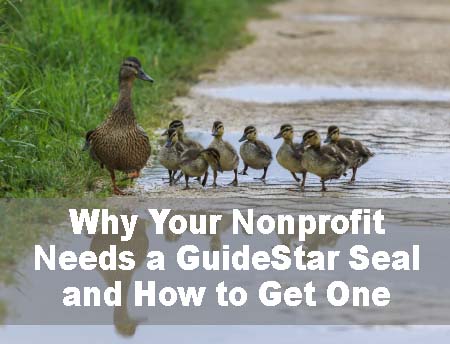Every nonprofit needs to take time to create a rated GuideStar profile. Why? Because not only is GuideStar visited by 8 million people annually. It also directly links your information to Facebook Fundraisers and dozens of other top fundraising and social media sites. Here is everything you need to know about GuideStar – what it is, where it came from, and how to use it to help your nonprofit advance your fundraising goals.
What exactly is GuideStar?
GuideStar is a comprehensive database of every single registered nonprofit. It compiles publicly available information for more than 2.5 million organizations in the United States. That includes tax IDs, contact information, website links, and 990 tax returns. GuideStar provides this information for free under its own nonprofit mission “to revolutionize philanthropy by providing information that advances transparency, enables users to make better decisions, and encourages charitable giving.” (Also read about watch dog groups for nonprofits.)
Founder of the “Overhead Myth”
Along with nonprofit rating giants Charity Navigator and BBB Wise Giving Alliance, GuideStar launched a campaign in 2013 to denounce the idea that overhead costs are directly related to charity success. Impact matters more than fundraising costs, salaries, rent, and keeping the lights on they argue.
GuideStar took the campaign further in 2016 by launching its new classification system for nonprofits. The top level, Platinum, allows a nonprofit to show its success by its impact rather than by its overhead ratio.
Guidestar Seals of Transparency
GuideStar does not rate nonprofits. It provides “seals of transparency.” Any nonprofit can participate for free by uploading specific information about their impact. Specifics of what you need to achieve one of four levels can be found on the website. In short:
-
- Bronze: the lowest of four levels, GuideStar indicates it only takes 30 minutes to provide basic information “so your organization can be found.” It is only contact information, your geographic focus, and a brief program description including the population you serve. This level is basic free advertising, like publishing in the yellow pages! Anyone that is searching for an organization with your mission focus in your area will find you, instantly.
-
- Silver: along with the requirements of Bronze, you need to include some basic financial information. They recommend an audited financial report. If you don’t have one, you can self-report whatever financials you feel are most appropriate.
-
- Gold: GuideStar claims this category is “so you can tell others about your work.” They ask you to answer, in addition to all the information in Bronze and Silver, 5 “charting impact” questions about your work. It is an opportunity to tell your story and to show what your goals are and your future strategies.
- Platinum: This is the highest category, what Guidestar deems is for showing “progress and results.” As opposed to showing just your financial health, it allows you to create custom metrics to measure your success and impact.
Specific benefits to having a Seal of Transparency on Guidestar
- 1. More and more foundations and corporate foundations allow you to automatically link your GuideStar profile while filling out your application. This saves you time when applying. It also shows your commitment to being transparent as you apply for new funding.
- 2. You can activate a “donate now” button directly on your profile if you have a seal. That gives you another free avenue to collect donations.
- 3. Your information is automatically updated and public to all major donor advised funds in the United States, AmazonSmiles, Network for Good, JustGive, and VolunteerMatch.
- 4. They allow you to use the seal logo at the level you are registered on your website, in your print materials, and on your social media to help brand your organization.
- 5. It is a quick and easy go to resource when a donor asks you about your financials or impact metrics. You just say, “Check us out on GuideStar.”
GuideStar is the number one resource for anyone, whether it be donors, donation seekers, or community members in need, to find information about nonprofits. Since all its programs are free to nonprofits in an effort to collect more data and promote greater transparency, all you need to do is spend a bit of time once a year to achieve a seal rating.
To get started, collect your information and visit the nonprofit profile update page here. In as little as half an hour you will have a seal!

